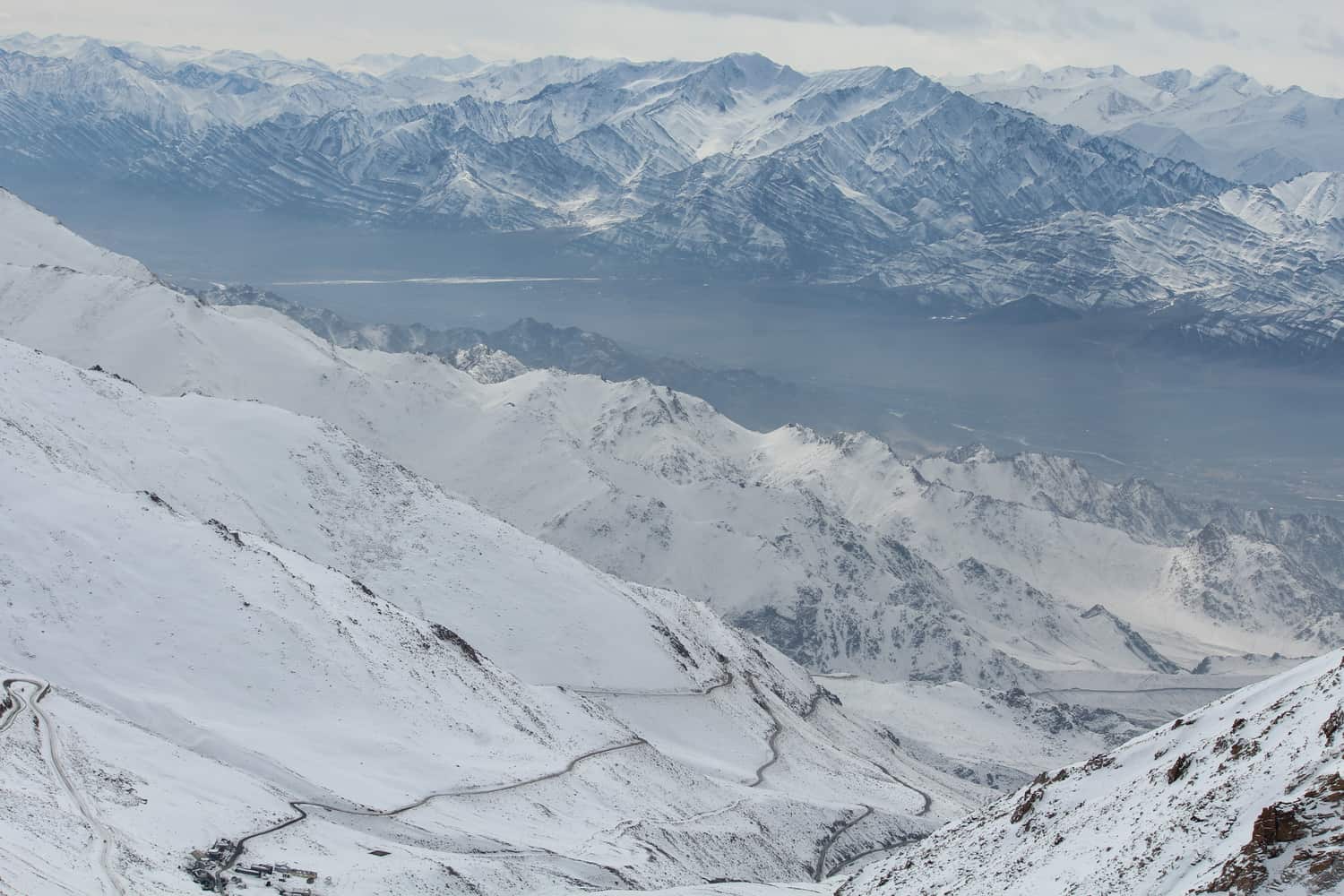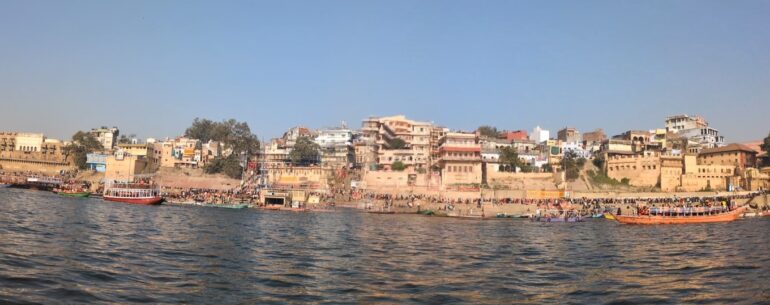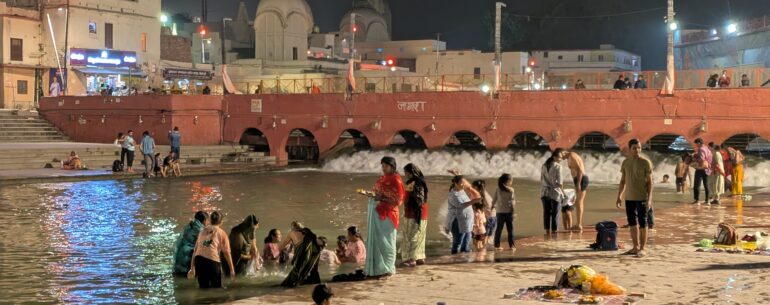At first sight, the location of Leh, the capital of Ladakh, is very impressive. Nestled in a valley with the Indus river and surrounded by snow capped mountain peaks. But the town itself is not very impressive. It does not seem to have a ‘charm’ of its own, a distinct identity.
Quite a few buildings under construction appeared to have been abandoned, but I later learnt that no construction activity happens during winter.
1. A day is adequate for local sightseeing
Local sightseeing in Leh can be done in a day. Places to visit include Leh Palace, Tsemo Castle, Shanti Stupa, Hall of Fame museum and Spituk monastery. I visited the main market also but most of the shops and restaurants are closed in winter. I was told they would open just before the tourist season.

Main market, Leh, Ladakh 
Leh palace, Ladakh 
Shanti Stupa, Leh, Ladakh 
Leh, Ladakh
But when it comes to day trips, visitors have some choices. Take any of the routes out of Leh-towards Chilling, towards Srinagar, towards Khardung La, towards Chang La or towards Manali, spectacular scenery greets you.
Another popular option is a tour of monasteries near Leh, and there are quite a few of them. Winter treks, especially Chader trek, also draws crowd.
I am repeating myself but Ladakh in winter is more about enjoying nature than sightseeing in the traditional sense. So don’t have a packed itinerary. I actually skipped several ‘places of tourist attraction’.
2. Drive towards Chilling
The second day, I drove first to the Magnetic hill. Parked the car as instructed but nothing happened. Guess it may be all hype about the car being pulled up the road, at least my local car driver thought so. And the car was a light weight Maruti van! Thereafter, passed by the frozen Indus river and onto the Sangam, where Indus and Zanskar rivers meet. Both the rivers were fully frozen but I was still tentative walking on it. It does feel a bit weird to be standing on a frozen river. The only restaurant here was closed.

Magnetic hill, Ladakh 
The frozen Indus river, Ladakh 
The frozen Zanskar river, Ladakh 
Meeting of Indus and Zanskar rivers at the Sangam, Ladakh
From Sangam, I drove along the frozen Zanskar river on Zanskar Valley road till Chilling which is the starting point for Chader trek. I am told the trek essentially progresses along the frozen Zansker river. It is a beautiful drive, not much snow or ice. Few bad patches on the road that were being cleared but otherwise good almost all the way. An alternate road to Manali via Chilling is under construction.

Drive to the Sangam, Ladakh 
Close up of rocky hill near Chilling, Ladakh 
Rocky hills near Chilling, Ladakh
On the way back, I had lunch at Gurudwara Pathar Sahib. Good lunch, free of cost. And then spent sometime at Spituk monastery. I love meditating in the prayer rooms of monasteries, with soft Buddhist music playing in the background. The views from the top are beautiful-one side is the Leh town and the other side is the frozen Indus river.

View from Spituk monastery, Leh, Ladakh
3. Drive to Khardung La
Khardung La is a mountain pass situated at an altitude of 17,980 ft. There does appear to be some disagreement on how high the Khardung La pass is(plus or minus 500 ft.) but the number I have quoted is etched on signboards at Khardung La. It is the gateway to Nubra valley and Siachen base camp. Given the importance of carrying supplies to Siachen for the Indian army, the route is open through the year, with occasional brief closures during heavy snowfall/landslides.
No longer no. 1 highest motorable pass
Until recently, Khardung La was the rated as the highest motorable mountain pass in the world. That distinction now belongs to Umling La Top, also in Ladakh, at 19,300 ft. It is close to India-China border and it appears that tourists are not allowed here.
Distance and time from Leh
Khardung La is only about 40 kms from Leh but the journey to the top takes upto 2 hours. Snow and ice on the road, especially after South Pullu slowed down my speed considerably. The road is in a very good condition all the way through. Overall, budget 4 to 4.5 hours for a round trip.
Journey more scenic than the top
There is nothing to see in Khardung La per se. But the views of the mountain ranges on the way to and from Khardung La are beyond words. It had snowed in the morning when I visited Khardung La and nobody will disagree how beautiful the mountains look when covered with snow.
At the top, it was a bit windy, with light snow falling and very cold at about -20 degrees Celsius. I just enjoyed the feeling that I was merely ~11,000 ft. below Mount Everest! More than 60% of the way.

The climb to Khardung La, Ladakh 
The climb to Khardung La, Ladakh 
View from Khardung La, Ladakh
Facilities
Nothing to eat or drink was available when I got there, with the tea house/smallish restaurant closed during winter. Apart from few army men, no one was around.
There is a toilet but given the freezing conditions, there were ice deposits all over. There is also a medical centre that can take care of visitors who may fall sick or feel uneasy because of the high altitude.
In any case, it is advisable not to hang around at this altitude for too long. In my case, given the very cold conditions, I spent about 30 minutes.
Inner Line/ Protected Area Permit
Required. Best to obtain online. My driver submitted it at South Pullu. See this link for details.
No fancy restaurants, bars etc.
In winter, Leh does not have what is usual in tourist towns-fancy restaurants and bars serving a variety of cuisine and drinks. Apart from Indian, Chinese and Tibetan food is more readily available.
Winter has its other challenges-other than apple, fresh fruits are not available. Variety of vegetables too is limited – Paneer and mushrooms are used quite liberally if you have ‘mixed vegetable’ curry.
In any case, unless you have a car available with you all the time, or live within walking distance of main market or other hotels, you have no choice but to eat in your hotel restaurant.
Leh is one location where it makes sense to have accommodation on a MAP(breakfast plus one meal) basis! In winter.



